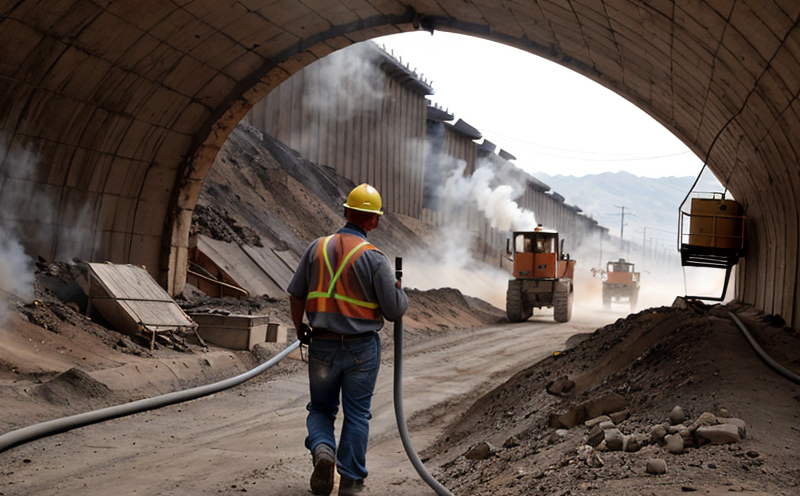ASTM D4532 Respirable Dust Sampling in Mines Testing
The ASTM D4532 standard is a critical tool for quality managers, compliance officers, and R&D engineers involved in mining operations. This testing procedure specifically addresses the challenge of respirable dust sampling within mines to ensure worker safety and regulatory compliance.
Respirable dust refers to particles that can be inhaled into the lungs, posing significant health risks if not controlled properly. Mining environments are particularly susceptible due to the nature of rock excavation and processing. The ASTM D4532 standard provides a method for sampling these respirable dust particles, which helps mining companies monitor air quality and implement necessary control measures.
The testing process involves the use of specialized equipment like cyclone samplers or impinger systems designed to capture airborne particulates according to specific size criteria. The collected samples are then analyzed using gravimetric methods or optical particle counters to determine the concentration of respirable dust present in the air.
Compliance with ASTM D4532 is crucial for several reasons. Firstly, it helps mining companies meet occupational health and safety regulations set by bodies such as OSHA (Occupational Safety and Health Administration). Secondly, compliance enhances the reputation of mining operations by demonstrating a commitment to worker well-being. Lastly, adherence to these standards can mitigate legal risks associated with workplace injuries.
The testing procedure outlined in ASTM D4532 is designed to be robust and reliable. It specifies detailed steps for sample collection, transportation, storage, and analysis. This ensures that the results obtained are accurate and representative of actual conditions within the mine environment. The standard also provides guidance on selecting appropriate sampling points based on ventilation patterns and potential dust sources.
One of the key aspects of ASTM D4532 is its emphasis on sample preparation before analysis. Proper handling and preservation of samples ensure that they remain stable during transport to the laboratory for testing. This includes sealing containers tightly, labeling them correctly, and noting environmental conditions such as temperature and humidity at each point in the chain of custody.
The analytical methods prescribed by ASTM D4532 can vary depending on the type of dust being measured and the required precision level. Common techniques include gravimetric analysis where the mass of the collected particulates is weighed after drying, or photometric measurement using devices like laser particle counters which provide real-time data.
It's important to note that while ASTM D4532 focuses primarily on respirable dust sampling in mines, it forms part of a broader suite of standards aimed at improving overall mine safety and environmental impact. By implementing this test protocol consistently across all relevant areas within the mining operation, companies can achieve more comprehensive compliance.
The importance of accurate and reliable respirable dust measurements cannot be overstated given the potential health impacts on workers exposed to high levels over prolonged periods. Regular monitoring through tests like those specified in ASTM D4532 allows for early detection of problematic trends which can then inform corrective actions aimed at reducing exposures.
Applied Standards
| Standard Name | Description |
|---|---|
| ASTM D4532-18 | This standard specifies procedures for collecting, transporting, and analyzing respirable dust samples in mining environments. It ensures accurate measurement of particulate matter that can pose respiratory hazards to workers. |
| OSHA 1910.250 | Occupational Safety and Health Administration's regulation requiring employers to protect employees from occupational exposure to harmful dusts, fumes, gases, or vapors. |
Eurolab Advantages
At Eurolab, we pride ourselves on providing comprehensive services that go beyond mere compliance. Our expertise in ASTM D4532 respirable dust sampling ensures that our clients receive accurate and reliable results every time.
We employ highly trained technicians who understand the nuances of this testing method and can provide detailed insights into your data. With state-of-the-art laboratory facilities equipped with advanced analytical instruments, we offer quick turnaround times without compromising on quality.
Our commitment to excellence extends beyond just technical capabilities; it encompasses a deep understanding of the mining industry's unique challenges. This allows us to tailor our services specifically to meet your needs, whether you're looking for routine testing or one-off assessments. Additionally, we offer continuous support through follow-up analyses and recommendations based on trends identified in your data.
Choosing Eurolab means choosing a partner dedicated to helping you maintain safe working conditions while ensuring regulatory compliance. Our reputation for delivering high-quality results has made us a trusted choice among leading mining companies worldwide.
Environmental and Sustainability Contributions
The implementation of ASTM D4532 respirable dust sampling in mines not only enhances occupational health but also contributes positively to environmental sustainability efforts. By monitoring air quality within the mining operations, companies can identify areas where improvements are needed and take proactive steps towards reducing emissions.
Reducing respirable dust levels benefits both human health and the environment by minimizing particulate matter that could otherwise escape into surrounding ecosystems. This helps preserve natural habitats and reduces pollution in local communities living near mining sites.
Mining companies committed to sustainability initiatives will find value in implementing this testing protocol as part of their broader strategy for environmental stewardship. It provides a clear picture of current conditions which can be used to set goals for future improvements, thereby contributing towards cleaner air and healthier work environments.





